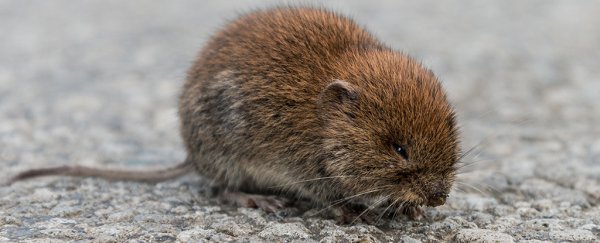When it comes to dividing animals along sex lines, evolution is known for getting creative. The chromosomes that determine baby-making functions have been reinvented so often throughout the ages, it's hard to keep track.
Some groups, like mammals, are thought to be fairly consistent in how they genetically cast lots in the game of reproduction. But creeping voles (Microtus oregoni) clearly didn't get that memo.
Now, US researchers have a better idea of just what's going on with the tiny oddball.
Fifty years ago, Japanese American evolutionary biologist Susumu Ohno pointed out some of the stranger features of how sex chromosomes are distributed in this adorable little North American rodent.
For example, while most placental and marsupial mammals have two X chromosomes in most of their cells, female creeping voles have just the one. Confusingly, where our sex cells halve their chromosome numbers, inside the tissues that produce ova in creeping voles you'll find a double-X arrangement.
The males, at least according to Ohno, are more like typical mammals with an X and Y in each of the body's non-sex cells and a single chromosome in the cell lines that give rise to sperm. Only for some reason it's always the same 'Y' chromosome.
Closely related voles don't show these characteristics, so whatever happened to the creeping vole, it had to have taken place within the past couple of million years.
It's been a puzzle begging to be solved, so biologist Scott Roy and his colleagues decided it was high time to investigate the creeping vole's genes, to work out just what made them so freaky.
"This is basically the weirdest sex chromosome system known to science," says Roy.
What they uncovered is even stranger than Ohno would have ever imagined.
Starting with the male, Roy and his team used cutting edge genetic sequencing technology to come up with scaffolds representing complete chromosomes.
They also used RNA sequencing to get a sense of what all of the genes were making in both the male and female voles, and compared this with similar transcript libraries taken from females of the related prairie vole (M. ochrogaster).
All of this revealed that there was no Y chromosome, at least in a form we might find in other mammals, such as rats and mice. What Ohno had labelled a Y chromosome turned out to be a fusion of ancestral X and a small handful of Y sequences.
On closer inspection of the female's X chromosome, the team found it was also a chimera of old genes, some of which included ancestral Y genes. These were now only expressed in female creeping voles.
That all adds up to a sex determination system made entirely of two X chromosomes, distinguished only by a small selection of old Y-genes. How females avoid becoming males, especially with the crucial sex-determining region Y (SRY) gene located on their X chromosome, just introduces further mystery.
It's all rather topsy-turvy, not to mention completely unexpected.
"Mammals, with few exceptions, are kind of boring," says Roy.
"Previously we would have thought something like this is impossible."
Although the research reveals important details on the chromosomal mash-up that help explain how it might have happened, biologists are still a long way from working out the evolutionary forces that nudged the vole down this path.
It's clear the poor old Y chromosome tends to be a delicate flower that evolution has no problem stripping down from time to time, including in our own species. Future studies on the vole's branch of the family tree might even reveal a few truths on our own fate.
One thing is for sure – when it comes to splitting up the sexes, evolution is quite happy to throw out the rule book.
This research was published in Science.
